Analyzing FDA Regulations: Impact on Healthcare and Public Health
VerifiedAdded on 2022/11/19
|8
|1599
|454
Report
AI Summary
This report provides an overview of the United States Food and Drug Administration (FDA), a crucial agency within the Department of Health and Human Services, responsible for safeguarding public health by regulating food, drugs, medical devices, and other related products. The report discusses the FDA's purpose, organizational structure, and key policy areas, including its role in enforcing the Federal Food, Drug, and Cosmetic Act. It highlights the agency's regulatory activities, such as inspecting manufacturing facilities and overseeing the development and approval of new products. Furthermore, the report analyzes the impact of FDA regulations on the healthcare industry, focusing on drug safety, prescription practices, and the balance between ensuring public safety and allowing access to innovative treatments. The report concludes by emphasizing the FDA's critical role in consumer protection and its broad regulatory scope, impacting a significant portion of consumer spending in the United States. Desklib offers a variety of solved assignments and study resources for students.
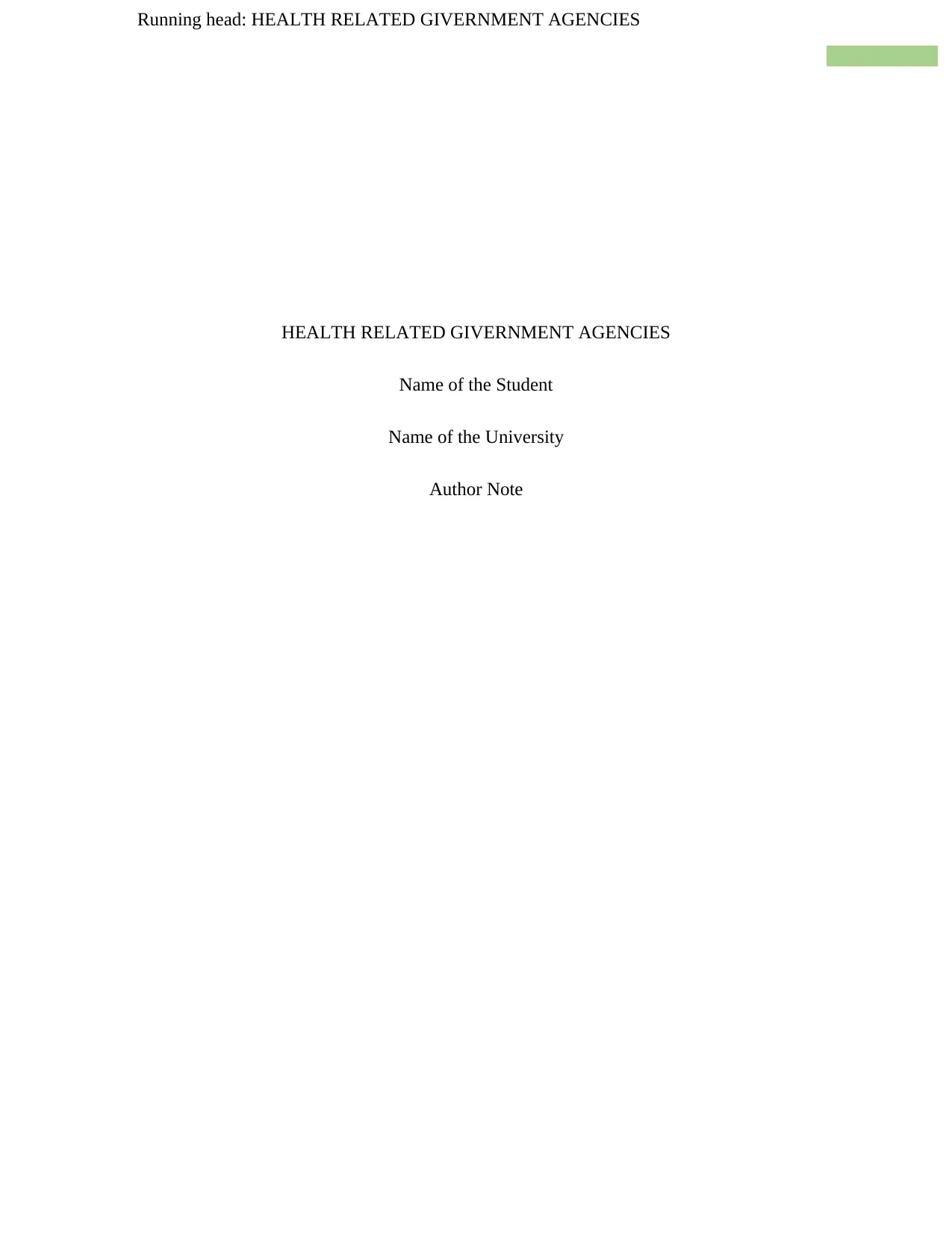
Running head: HEALTH RELATED GIVERNMENT AGENCIES
HEALTH RELATED GIVERNMENT AGENCIES
Name of the Student
Name of the University
Author Note
HEALTH RELATED GIVERNMENT AGENCIES
Name of the Student
Name of the University
Author Note
Paraphrase This Document
Need a fresh take? Get an instant paraphrase of this document with our AI Paraphraser
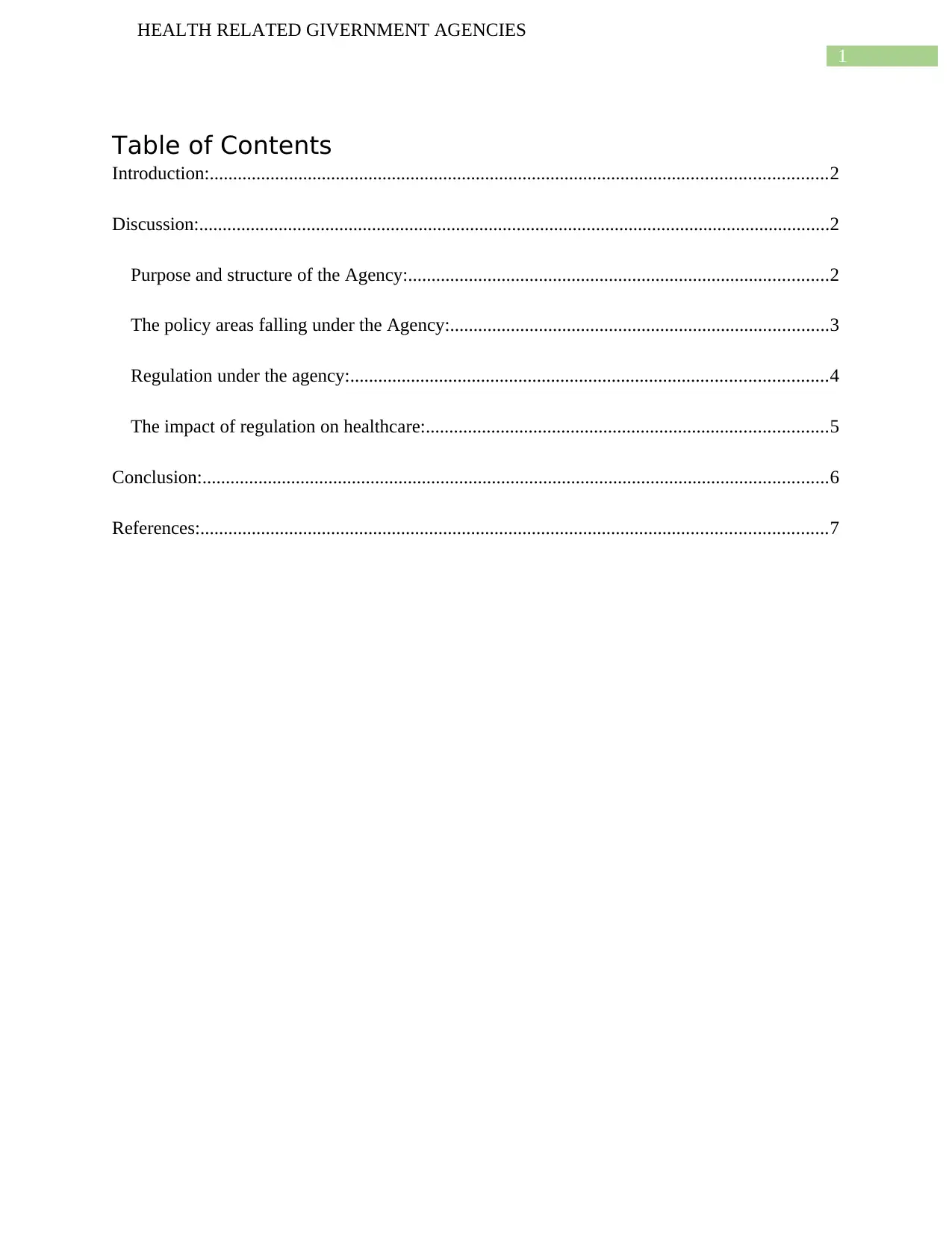
1
HEALTH RELATED GIVERNMENT AGENCIES
Table of Contents
Introduction:....................................................................................................................................2
Discussion:.......................................................................................................................................2
Purpose and structure of the Agency:..........................................................................................2
The policy areas falling under the Agency:.................................................................................3
Regulation under the agency:......................................................................................................4
The impact of regulation on healthcare:......................................................................................5
Conclusion:......................................................................................................................................6
References:......................................................................................................................................7
HEALTH RELATED GIVERNMENT AGENCIES
Table of Contents
Introduction:....................................................................................................................................2
Discussion:.......................................................................................................................................2
Purpose and structure of the Agency:..........................................................................................2
The policy areas falling under the Agency:.................................................................................3
Regulation under the agency:......................................................................................................4
The impact of regulation on healthcare:......................................................................................5
Conclusion:......................................................................................................................................6
References:......................................................................................................................................7
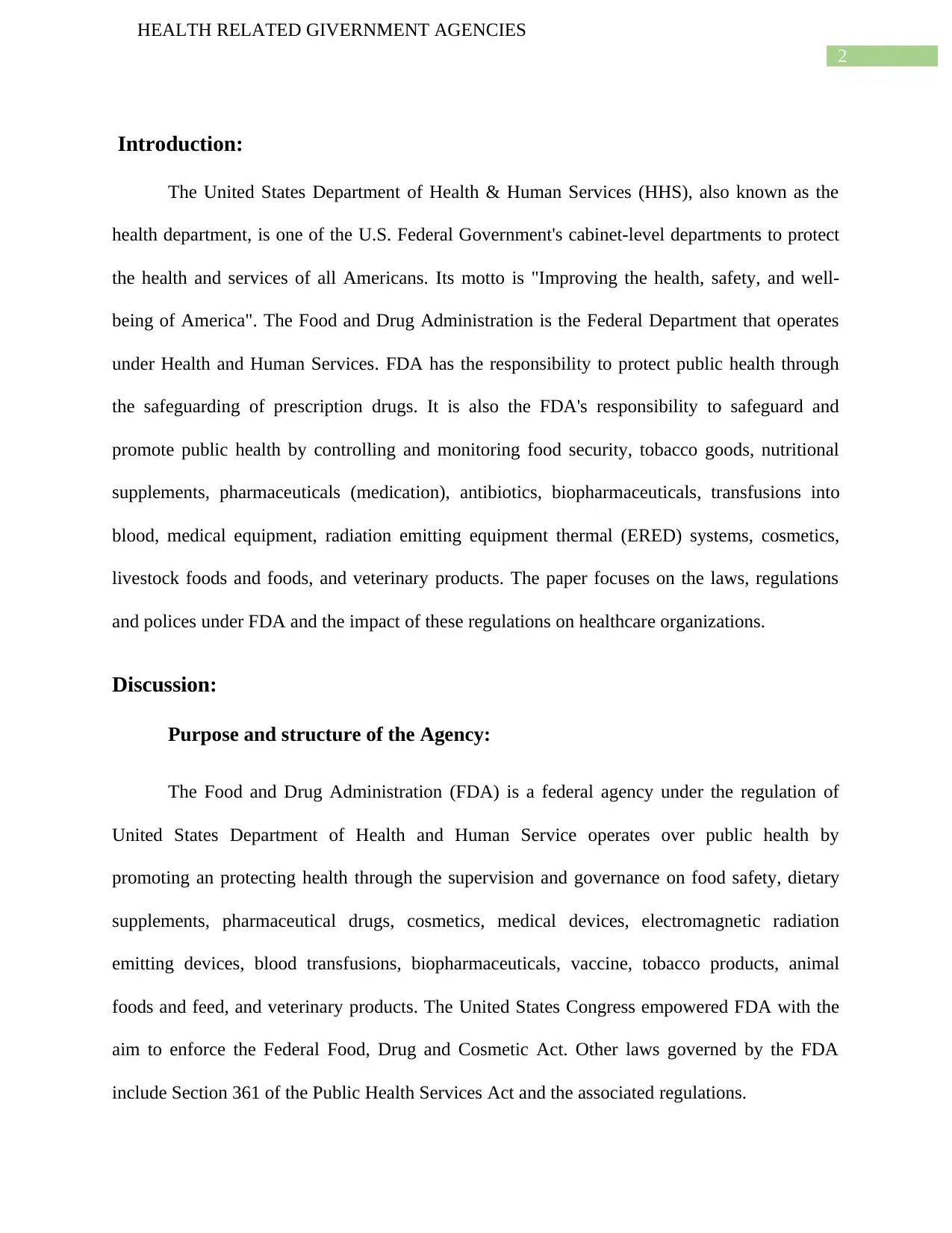
2
HEALTH RELATED GIVERNMENT AGENCIES
Introduction:
The United States Department of Health & Human Services (HHS), also known as the
health department, is one of the U.S. Federal Government's cabinet-level departments to protect
the health and services of all Americans. Its motto is "Improving the health, safety, and well-
being of America". The Food and Drug Administration is the Federal Department that operates
under Health and Human Services. FDA has the responsibility to protect public health through
the safeguarding of prescription drugs. It is also the FDA's responsibility to safeguard and
promote public health by controlling and monitoring food security, tobacco goods, nutritional
supplements, pharmaceuticals (medication), antibiotics, biopharmaceuticals, transfusions into
blood, medical equipment, radiation emitting equipment thermal (ERED) systems, cosmetics,
livestock foods and foods, and veterinary products. The paper focuses on the laws, regulations
and polices under FDA and the impact of these regulations on healthcare organizations.
Discussion:
Purpose and structure of the Agency:
The Food and Drug Administration (FDA) is a federal agency under the regulation of
United States Department of Health and Human Service operates over public health by
promoting an protecting health through the supervision and governance on food safety, dietary
supplements, pharmaceutical drugs, cosmetics, medical devices, electromagnetic radiation
emitting devices, blood transfusions, biopharmaceuticals, vaccine, tobacco products, animal
foods and feed, and veterinary products. The United States Congress empowered FDA with the
aim to enforce the Federal Food, Drug and Cosmetic Act. Other laws governed by the FDA
include Section 361 of the Public Health Services Act and the associated regulations.
HEALTH RELATED GIVERNMENT AGENCIES
Introduction:
The United States Department of Health & Human Services (HHS), also known as the
health department, is one of the U.S. Federal Government's cabinet-level departments to protect
the health and services of all Americans. Its motto is "Improving the health, safety, and well-
being of America". The Food and Drug Administration is the Federal Department that operates
under Health and Human Services. FDA has the responsibility to protect public health through
the safeguarding of prescription drugs. It is also the FDA's responsibility to safeguard and
promote public health by controlling and monitoring food security, tobacco goods, nutritional
supplements, pharmaceuticals (medication), antibiotics, biopharmaceuticals, transfusions into
blood, medical equipment, radiation emitting equipment thermal (ERED) systems, cosmetics,
livestock foods and foods, and veterinary products. The paper focuses on the laws, regulations
and polices under FDA and the impact of these regulations on healthcare organizations.
Discussion:
Purpose and structure of the Agency:
The Food and Drug Administration (FDA) is a federal agency under the regulation of
United States Department of Health and Human Service operates over public health by
promoting an protecting health through the supervision and governance on food safety, dietary
supplements, pharmaceutical drugs, cosmetics, medical devices, electromagnetic radiation
emitting devices, blood transfusions, biopharmaceuticals, vaccine, tobacco products, animal
foods and feed, and veterinary products. The United States Congress empowered FDA with the
aim to enforce the Federal Food, Drug and Cosmetic Act. Other laws governed by the FDA
include Section 361 of the Public Health Services Act and the associated regulations.
⊘ This is a preview!⊘
Do you want full access?
Subscribe today to unlock all pages.

Trusted by 1+ million students worldwide
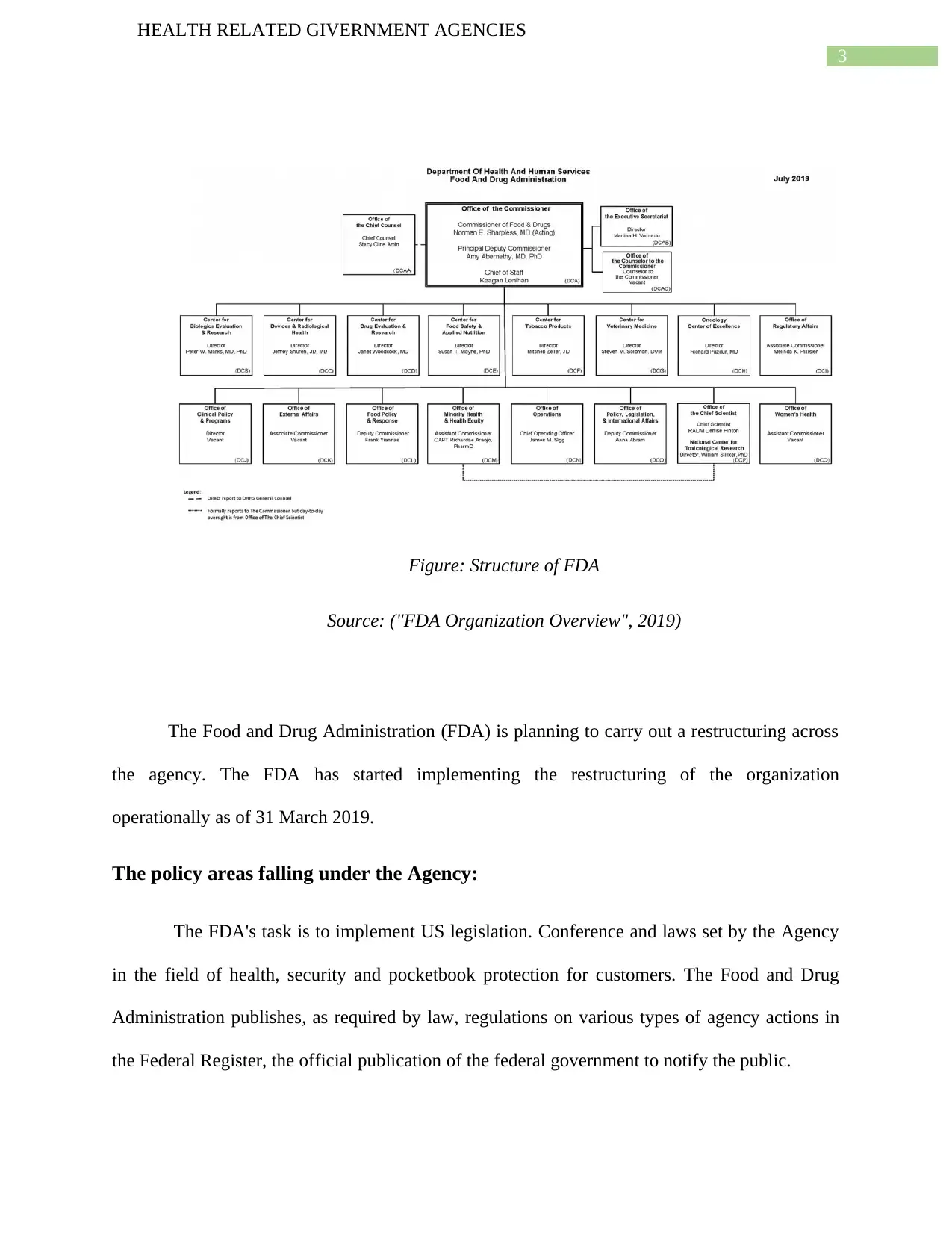
3
HEALTH RELATED GIVERNMENT AGENCIES
Figure: Structure of FDA
Source: ("FDA Organization Overview", 2019)
The Food and Drug Administration (FDA) is planning to carry out a restructuring across
the agency. The FDA has started implementing the restructuring of the organization
operationally as of 31 March 2019.
The policy areas falling under the Agency:
The FDA's task is to implement US legislation. Conference and laws set by the Agency
in the field of health, security and pocketbook protection for customers. The Food and Drug
Administration publishes, as required by law, regulations on various types of agency actions in
the Federal Register, the official publication of the federal government to notify the public.
HEALTH RELATED GIVERNMENT AGENCIES
Figure: Structure of FDA
Source: ("FDA Organization Overview", 2019)
The Food and Drug Administration (FDA) is planning to carry out a restructuring across
the agency. The FDA has started implementing the restructuring of the organization
operationally as of 31 March 2019.
The policy areas falling under the Agency:
The FDA's task is to implement US legislation. Conference and laws set by the Agency
in the field of health, security and pocketbook protection for customers. The Food and Drug
Administration publishes, as required by law, regulations on various types of agency actions in
the Federal Register, the official publication of the federal government to notify the public.
Paraphrase This Document
Need a fresh take? Get an instant paraphrase of this document with our AI Paraphraser
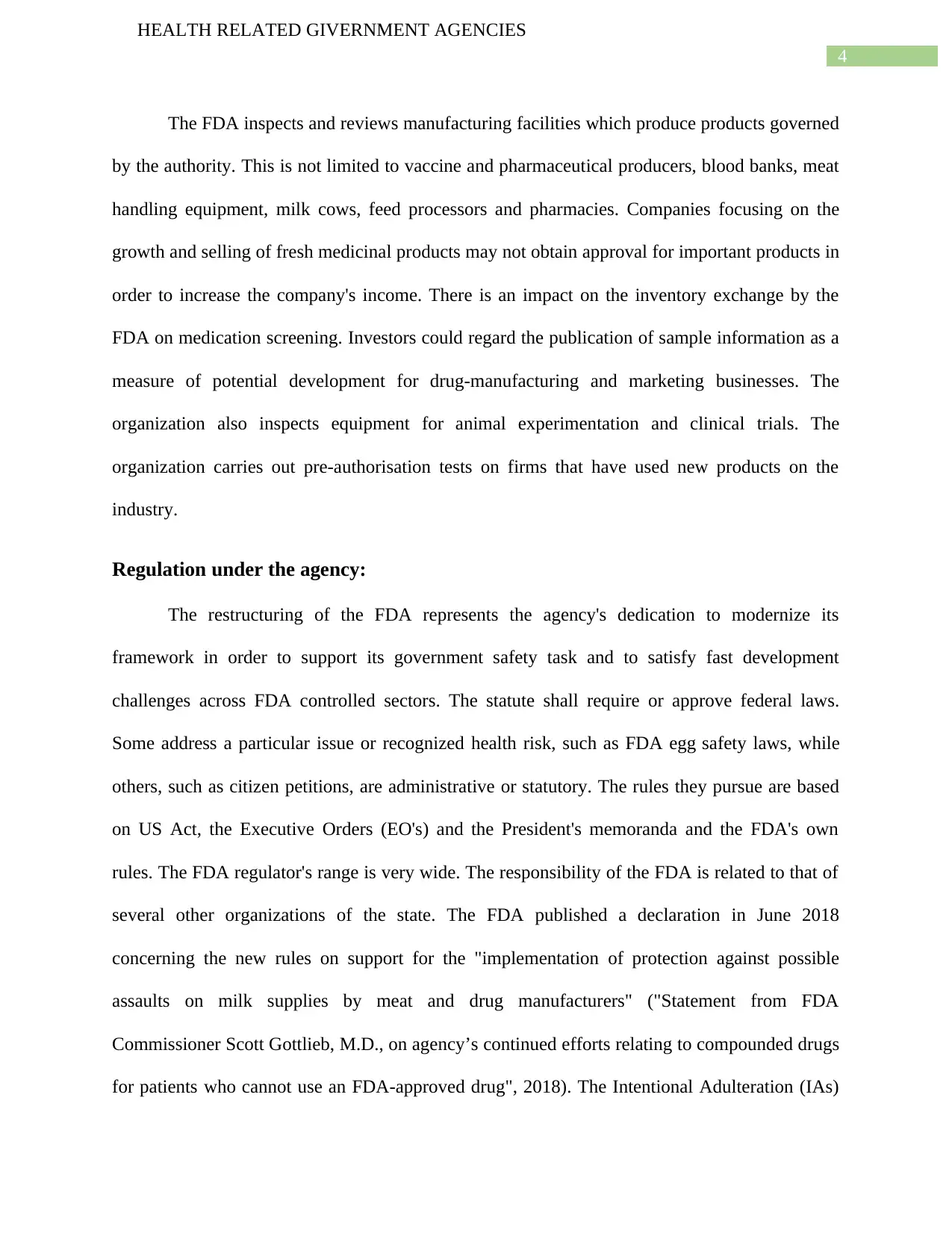
4
HEALTH RELATED GIVERNMENT AGENCIES
The FDA inspects and reviews manufacturing facilities which produce products governed
by the authority. This is not limited to vaccine and pharmaceutical producers, blood banks, meat
handling equipment, milk cows, feed processors and pharmacies. Companies focusing on the
growth and selling of fresh medicinal products may not obtain approval for important products in
order to increase the company's income. There is an impact on the inventory exchange by the
FDA on medication screening. Investors could regard the publication of sample information as a
measure of potential development for drug-manufacturing and marketing businesses. The
organization also inspects equipment for animal experimentation and clinical trials. The
organization carries out pre-authorisation tests on firms that have used new products on the
industry.
Regulation under the agency:
The restructuring of the FDA represents the agency's dedication to modernize its
framework in order to support its government safety task and to satisfy fast development
challenges across FDA controlled sectors. The statute shall require or approve federal laws.
Some address a particular issue or recognized health risk, such as FDA egg safety laws, while
others, such as citizen petitions, are administrative or statutory. The rules they pursue are based
on US Act, the Executive Orders (EO's) and the President's memoranda and the FDA's own
rules. The FDA regulator's range is very wide. The responsibility of the FDA is related to that of
several other organizations of the state. The FDA published a declaration in June 2018
concerning the new rules on support for the "implementation of protection against possible
assaults on milk supplies by meat and drug manufacturers" ("Statement from FDA
Commissioner Scott Gottlieb, M.D., on agency’s continued efforts relating to compounded drugs
for patients who cannot use an FDA-approved drug", 2018). The Intentional Adulteration (IAs)
HEALTH RELATED GIVERNMENT AGENCIES
The FDA inspects and reviews manufacturing facilities which produce products governed
by the authority. This is not limited to vaccine and pharmaceutical producers, blood banks, meat
handling equipment, milk cows, feed processors and pharmacies. Companies focusing on the
growth and selling of fresh medicinal products may not obtain approval for important products in
order to increase the company's income. There is an impact on the inventory exchange by the
FDA on medication screening. Investors could regard the publication of sample information as a
measure of potential development for drug-manufacturing and marketing businesses. The
organization also inspects equipment for animal experimentation and clinical trials. The
organization carries out pre-authorisation tests on firms that have used new products on the
industry.
Regulation under the agency:
The restructuring of the FDA represents the agency's dedication to modernize its
framework in order to support its government safety task and to satisfy fast development
challenges across FDA controlled sectors. The statute shall require or approve federal laws.
Some address a particular issue or recognized health risk, such as FDA egg safety laws, while
others, such as citizen petitions, are administrative or statutory. The rules they pursue are based
on US Act, the Executive Orders (EO's) and the President's memoranda and the FDA's own
rules. The FDA regulator's range is very wide. The responsibility of the FDA is related to that of
several other organizations of the state. The FDA published a declaration in June 2018
concerning the new rules on support for the "implementation of protection against possible
assaults on milk supplies by meat and drug manufacturers" ("Statement from FDA
Commissioner Scott Gottlieb, M.D., on agency’s continued efforts relating to compounded drugs
for patients who cannot use an FDA-approved drug", 2018). The Intentional Adulteration (IAs)
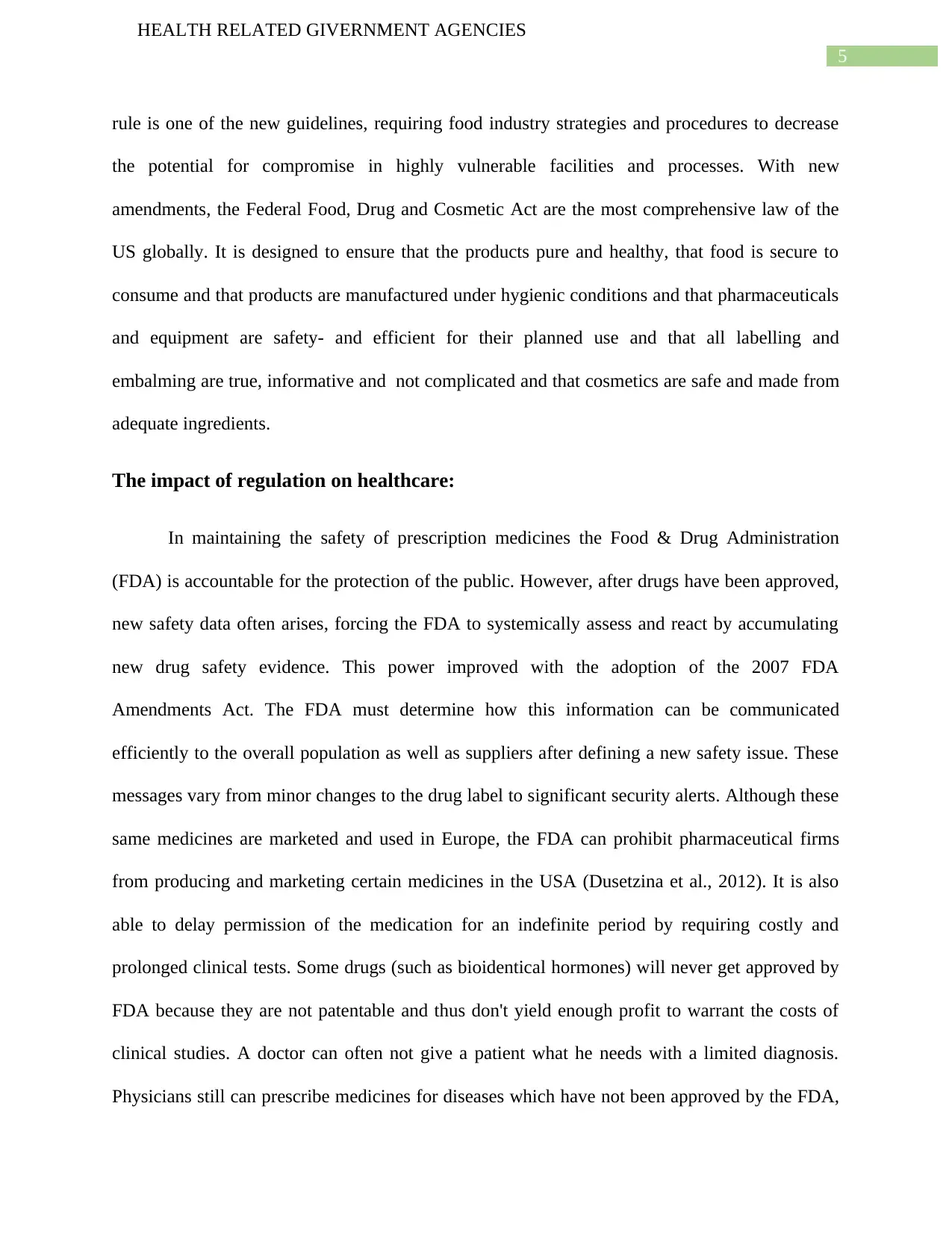
5
HEALTH RELATED GIVERNMENT AGENCIES
rule is one of the new guidelines, requiring food industry strategies and procedures to decrease
the potential for compromise in highly vulnerable facilities and processes. With new
amendments, the Federal Food, Drug and Cosmetic Act are the most comprehensive law of the
US globally. It is designed to ensure that the products pure and healthy, that food is secure to
consume and that products are manufactured under hygienic conditions and that pharmaceuticals
and equipment are safety- and efficient for their planned use and that all labelling and
embalming are true, informative and not complicated and that cosmetics are safe and made from
adequate ingredients.
The impact of regulation on healthcare:
In maintaining the safety of prescription medicines the Food & Drug Administration
(FDA) is accountable for the protection of the public. However, after drugs have been approved,
new safety data often arises, forcing the FDA to systemically assess and react by accumulating
new drug safety evidence. This power improved with the adoption of the 2007 FDA
Amendments Act. The FDA must determine how this information can be communicated
efficiently to the overall population as well as suppliers after defining a new safety issue. These
messages vary from minor changes to the drug label to significant security alerts. Although these
same medicines are marketed and used in Europe, the FDA can prohibit pharmaceutical firms
from producing and marketing certain medicines in the USA (Dusetzina et al., 2012). It is also
able to delay permission of the medication for an indefinite period by requiring costly and
prolonged clinical tests. Some drugs (such as bioidentical hormones) will never get approved by
FDA because they are not patentable and thus don't yield enough profit to warrant the costs of
clinical studies. A doctor can often not give a patient what he needs with a limited diagnosis.
Physicians still can prescribe medicines for diseases which have not been approved by the FDA,
HEALTH RELATED GIVERNMENT AGENCIES
rule is one of the new guidelines, requiring food industry strategies and procedures to decrease
the potential for compromise in highly vulnerable facilities and processes. With new
amendments, the Federal Food, Drug and Cosmetic Act are the most comprehensive law of the
US globally. It is designed to ensure that the products pure and healthy, that food is secure to
consume and that products are manufactured under hygienic conditions and that pharmaceuticals
and equipment are safety- and efficient for their planned use and that all labelling and
embalming are true, informative and not complicated and that cosmetics are safe and made from
adequate ingredients.
The impact of regulation on healthcare:
In maintaining the safety of prescription medicines the Food & Drug Administration
(FDA) is accountable for the protection of the public. However, after drugs have been approved,
new safety data often arises, forcing the FDA to systemically assess and react by accumulating
new drug safety evidence. This power improved with the adoption of the 2007 FDA
Amendments Act. The FDA must determine how this information can be communicated
efficiently to the overall population as well as suppliers after defining a new safety issue. These
messages vary from minor changes to the drug label to significant security alerts. Although these
same medicines are marketed and used in Europe, the FDA can prohibit pharmaceutical firms
from producing and marketing certain medicines in the USA (Dusetzina et al., 2012). It is also
able to delay permission of the medication for an indefinite period by requiring costly and
prolonged clinical tests. Some drugs (such as bioidentical hormones) will never get approved by
FDA because they are not patentable and thus don't yield enough profit to warrant the costs of
clinical studies. A doctor can often not give a patient what he needs with a limited diagnosis.
Physicians still can prescribe medicines for diseases which have not been approved by the FDA,
⊘ This is a preview!⊘
Do you want full access?
Subscribe today to unlock all pages.

Trusted by 1+ million students worldwide
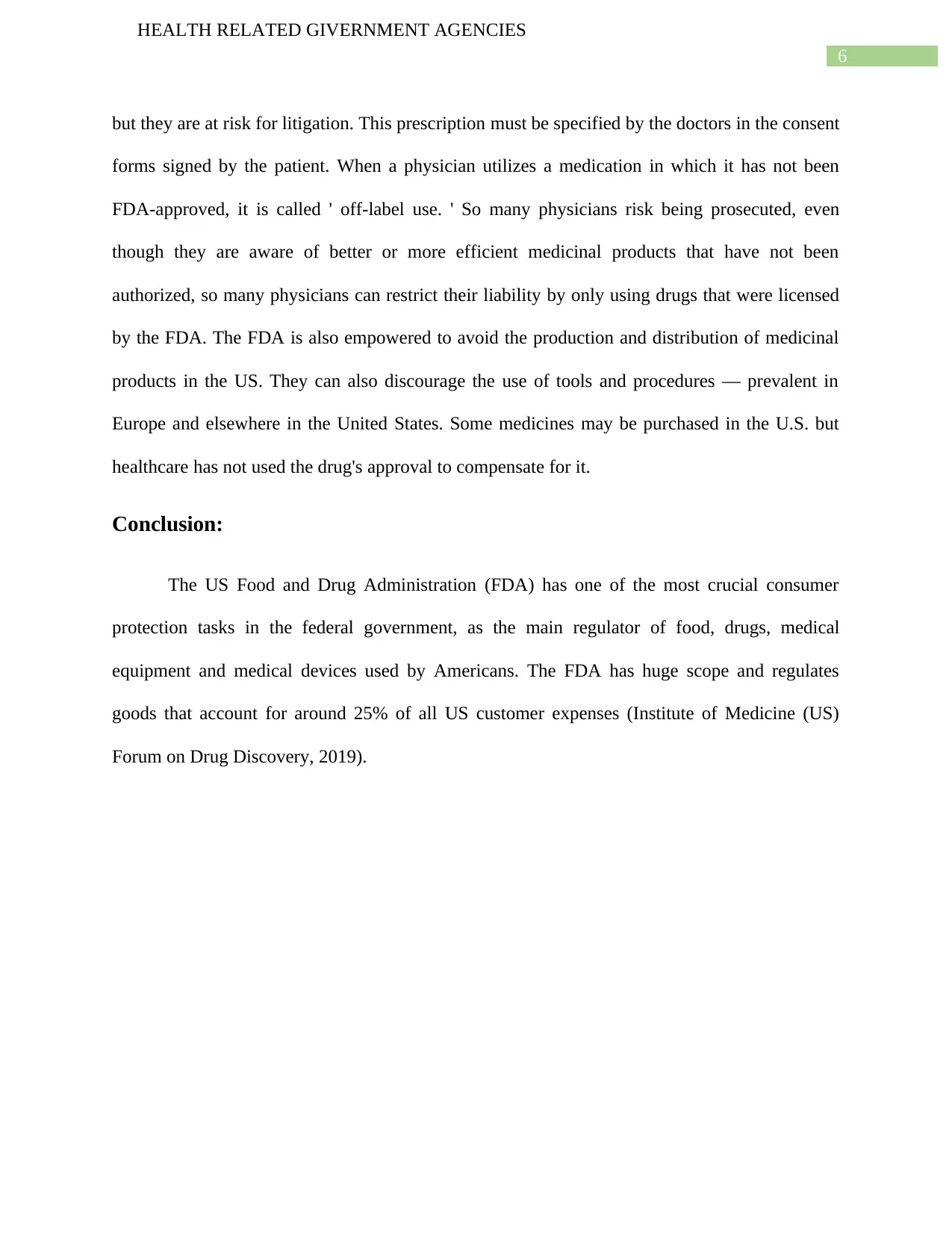
6
HEALTH RELATED GIVERNMENT AGENCIES
but they are at risk for litigation. This prescription must be specified by the doctors in the consent
forms signed by the patient. When a physician utilizes a medication in which it has not been
FDA-approved, it is called ' off-label use. ' So many physicians risk being prosecuted, even
though they are aware of better or more efficient medicinal products that have not been
authorized, so many physicians can restrict their liability by only using drugs that were licensed
by the FDA. The FDA is also empowered to avoid the production and distribution of medicinal
products in the US. They can also discourage the use of tools and procedures — prevalent in
Europe and elsewhere in the United States. Some medicines may be purchased in the U.S. but
healthcare has not used the drug's approval to compensate for it.
Conclusion:
The US Food and Drug Administration (FDA) has one of the most crucial consumer
protection tasks in the federal government, as the main regulator of food, drugs, medical
equipment and medical devices used by Americans. The FDA has huge scope and regulates
goods that account for around 25% of all US customer expenses (Institute of Medicine (US)
Forum on Drug Discovery, 2019).
HEALTH RELATED GIVERNMENT AGENCIES
but they are at risk for litigation. This prescription must be specified by the doctors in the consent
forms signed by the patient. When a physician utilizes a medication in which it has not been
FDA-approved, it is called ' off-label use. ' So many physicians risk being prosecuted, even
though they are aware of better or more efficient medicinal products that have not been
authorized, so many physicians can restrict their liability by only using drugs that were licensed
by the FDA. The FDA is also empowered to avoid the production and distribution of medicinal
products in the US. They can also discourage the use of tools and procedures — prevalent in
Europe and elsewhere in the United States. Some medicines may be purchased in the U.S. but
healthcare has not used the drug's approval to compensate for it.
Conclusion:
The US Food and Drug Administration (FDA) has one of the most crucial consumer
protection tasks in the federal government, as the main regulator of food, drugs, medical
equipment and medical devices used by Americans. The FDA has huge scope and regulates
goods that account for around 25% of all US customer expenses (Institute of Medicine (US)
Forum on Drug Discovery, 2019).
Paraphrase This Document
Need a fresh take? Get an instant paraphrase of this document with our AI Paraphraser
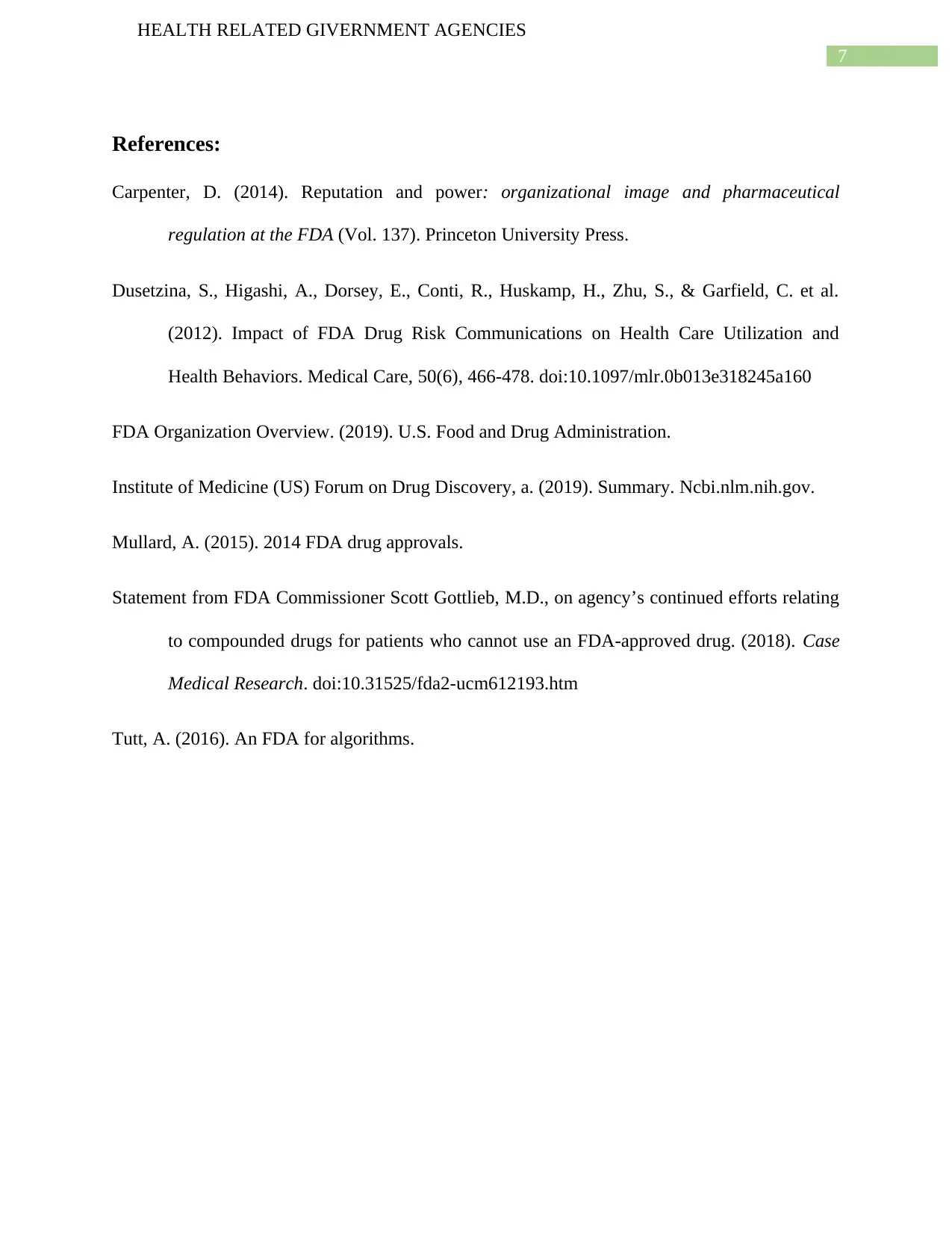
7
HEALTH RELATED GIVERNMENT AGENCIES
References:
Carpenter, D. (2014). Reputation and power: organizational image and pharmaceutical
regulation at the FDA (Vol. 137). Princeton University Press.
Dusetzina, S., Higashi, A., Dorsey, E., Conti, R., Huskamp, H., Zhu, S., & Garfield, C. et al.
(2012). Impact of FDA Drug Risk Communications on Health Care Utilization and
Health Behaviors. Medical Care, 50(6), 466-478. doi:10.1097/mlr.0b013e318245a160
FDA Organization Overview. (2019). U.S. Food and Drug Administration.
Institute of Medicine (US) Forum on Drug Discovery, a. (2019). Summary. Ncbi.nlm.nih.gov.
Mullard, A. (2015). 2014 FDA drug approvals.
Statement from FDA Commissioner Scott Gottlieb, M.D., on agency’s continued efforts relating
to compounded drugs for patients who cannot use an FDA-approved drug. (2018). Case
Medical Research. doi:10.31525/fda2-ucm612193.htm
Tutt, A. (2016). An FDA for algorithms.
HEALTH RELATED GIVERNMENT AGENCIES
References:
Carpenter, D. (2014). Reputation and power: organizational image and pharmaceutical
regulation at the FDA (Vol. 137). Princeton University Press.
Dusetzina, S., Higashi, A., Dorsey, E., Conti, R., Huskamp, H., Zhu, S., & Garfield, C. et al.
(2012). Impact of FDA Drug Risk Communications on Health Care Utilization and
Health Behaviors. Medical Care, 50(6), 466-478. doi:10.1097/mlr.0b013e318245a160
FDA Organization Overview. (2019). U.S. Food and Drug Administration.
Institute of Medicine (US) Forum on Drug Discovery, a. (2019). Summary. Ncbi.nlm.nih.gov.
Mullard, A. (2015). 2014 FDA drug approvals.
Statement from FDA Commissioner Scott Gottlieb, M.D., on agency’s continued efforts relating
to compounded drugs for patients who cannot use an FDA-approved drug. (2018). Case
Medical Research. doi:10.31525/fda2-ucm612193.htm
Tutt, A. (2016). An FDA for algorithms.
1 out of 8
Related Documents
Your All-in-One AI-Powered Toolkit for Academic Success.
+13062052269
info@desklib.com
Available 24*7 on WhatsApp / Email
![[object Object]](/_next/static/media/star-bottom.7253800d.svg)
Unlock your academic potential
Copyright © 2020–2025 A2Z Services. All Rights Reserved. Developed and managed by ZUCOL.





